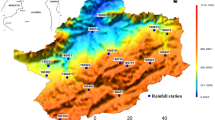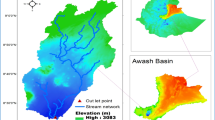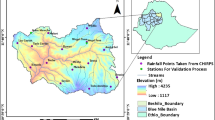Abstract
Hydrological effects comprise the changes in soil use to comprehend the mechanisms of future climate and land use. The significant temporal trend was identified in this study as being performed monthly, seasonal time scales using rainfall data from 39 monitoring stations throughout the Sheonath Basin, subdivided into five effective weighted stations by the creation of Thiessen polygon over Sheonath River Basin in Chhattisgarh State for the period of 1980–2012. Hydro-meteorological factors are evaluated using a combined trend detection technique. The findings show a substantial downward trend at 5% significance level, an average of −0.10 mm per year for all five monitoring stations for the month of March, May, September, October, December, January, and February similar to June, July, August, April, and November reveal the upward trend at 5% significance level, an average of 0.12 mm per year. While the trend continues in various phases such as winter and pre-monsoon seasons, the trend is considerably declining an average of −0.041 and −0.009 mm per year, respectively, for all five monitoring stations and post-monsoon periods; simga, andhayakore, and patharidih monitoring stations represent a downward trend at an average of −0.0084 mm per year. The variability of rainfall has resulted to the conclusion that the amount of rainfall variability decreases by 5.56% compared to the average annual rainfall variability in the Rajnandgaon, Durg, and Kawardha Districts during the Kharif season, and the rainfall variability decreases by 93.14%, 93.88%, and 93.34% compared to the annual average rainfall variability in the Rajnandgaon, Durg, and Kawardha Districts during the rabi season, respectively. Therefore, there is a need for improvement in the eastern zone.
Access provided by Autonomous University of Puebla. Download conference paper PDF
Similar content being viewed by others
Keywords
- Trend detection
- Rainfall
- Kendall tau statistics
- Theil–sen slope estimator
- Rainfall variability
- Rain-fed crop yield
1 Introduction
Water is a natural resource and its availability is a major problem for any venture being planned, developed, and managed. Indian farming focuses primarily on rainfall distribution and allocation. Rainfall distribution is the primary variable in the preparation and governance of water resource activities such as agricultural production, water requirement alterations, irrigation, and reservoir activities [1]. The climate change is related to distinct parameters of hydro-meteorology behavior relative to two distinct phases. Variability in climate is not a very short-term technique. A noticeable change in the climate takes years or centuries [2]. The temperature variations and the irregular rainfall first appear in the picture when the term climate changes are coined. Because of poor adjustment strategies and a very large population, this can contribute to serious damaging conditions from the perspective of India [3]. Intensive flooding and severe drought in distinct regions of the country can concurrently prevail [4]. Extensive human interventions will further accelerate this. But the issue to be studied is that, whether it is a drought or flood, an important effect on these parts will be the variability in precipitation [5]. In India, owing to the southwest monsoon, that is, June–September precipitation, it counts for rainfall. Also, in view of the rise in temperature, rainfall is expected to rise in certain parts of the globe in favor of such climate change. A number of researches worked on trend analysis of rainfall in different geographical locations of India. Non-parametric and linear regression test approaches were used in most of the researches to identify trends. In this study, we used non-parametric techniques because World Meteorological Organization (WMO) suggests it is free from any type of distribution and robust against outliers to detect important monotonous upward and downward trends for distinct climatological and hydrological time scales [4].
2 Study Area and Data Used
Sheonath (also called Seonath) is located in Chhattisgarh region plains of India. This basin extends from 20°16′ to 22°41′N latitude to 80°25′ to 82°35′E longitude. A large part of the Upper Mahanadi Valley is occupied by the basin [6]. Sheonath is Mahanadi River’s longest tributary, spanning a length of 380 km. It originates near the village of Panabaras in the district of Rajnandgaon, Chhattisgarh, 624 meters above sea level. The main tributaries are Arpa, Tandula, Agar, Kharun, Maniyari, and Hamp [5]. The basin’s area is 30,560 km2. The watershed topography is basically flat. The Sheonath Basin has a tropical wet and dry environment; from March to June, temperatures can be highly warm, though moderate throughout the year. The watershed receives an average precipitation of 1150 mm per year with a large proportion contributing to the rainy season from June to early October, followed by the post-monsoon period from October to December and gathered daily rainfall information for 39 meteorological stations across the Sheonath River Basin to evaluate space and time variation for a span of 30 years (from 1980 to 2010). The five stations, namely, Simga Jondhra, Patharidih, Kotni, and Andhiyakore are the Central Water Commission (CWC) stations used in this study. Location map of the Sheonath River Basin is shown in Fig. 1.
2.1 Data Used
The various sets of data have been used were the study course of Chhattisgarh State. The basic data, which were collected and used during the entire works, are soil physiography, soil type, soil depth, DEM, precipitation, temperature, length of growing period, land use/land cover, available water capacity (AWC), and administrative boundary. All the data were collected by visiting respective areas of the concerned state. The maps relating to Chhattisgarh’s soil resources are collected as first information and second most important parameters such as rainfall and temperature are collected from different meteorological stations of Chhattisgarh.
2.2 Rainfall Variability
The degree to which the quantity of rainfall changes across a region or over time is a significant feature of the climate of a region called rainfall variability in climatology and meteorology [7]. Analysis of rainfall is crucial for any area in terms of crop planning. To maintain crop yield in the rain-fed scenario at important concentrations, planning, and management of rain-fed crops in combination with frequent rainfall patterns in the area is essential. For rain-fed crop planning, surveys of rainfall, in particular, offer more data about its variability and probability assessment. Among the climatic elements, rainfall is the most important single factor by climatic analyzer and farmers which determines rainfall on the different time scale and daily rainfall plays an important role in weather phenomena in tropical countries and helps to determine the hydrological and agriculture land use potential investigation. Further, accurate knowledge of agro-climate conditions is critical to the effective planning of crops in any specific area [6]. This sort of knowledge is more significant in a rain-fed area where crop production depends on climatic parameter and monsoon incoherence. The distribution of rainfall in the rain-fed area is, therefore, a significant determinant of crop yield [8]. In this context, it is necessary to collect, analyze, and examine the region’s historical weather data in order to characterize the region’s agricultural climate.
2.3 Annual Average Rainfall
The Chhattisgarh State has been divided into five major categories such as very high rainfall zone (1600 mm), high rainfall (1500–1600 mm), medium rainfall (1400–1500 mm), low rainfall (1300–1400 mm), and very low rainfall (rainfall < 1300 mm) [6]. The spatial distribution of rainfall indicates that the southeastern Baster Region comprising some parts of Dantewada and Jagdalpur, the southern portion of the southern mountains, some parts of Sarguja and most parts of Jashpur and northwestern part of Chhattisgarh, some parts of Janjgir, Raipur, Mahasamund and most parts of Raigarh perceive high to very high precipitation. The reason is that monsoon’s onset is quite early in this part of the country, not in other areas of the country, so monsoon remains active in this portion for a longer period [9]. Due to the undulating area, another region that contributes to high rainfall may be dense forest cover and orographic rainfall industry. Medium rainfall is received throughout Bijapur District and parts of Dantewada, Narayanpur, Koriya, Jagdalpur, Bilaspur, Korba, Sarguja, Janjgir, Mahasamund, Raigarh, and Raipur. The position and region of the stations in the basin are shown on the Thiessen polygon map in Fig. 2 (Table 1).
3 Methodology
In this study, daily rainfall data is used to generate monthly and seasonal time series for investigating spatiotemporal changes in rainfall pattern. Ideally, rainfall data used to investigate patterns of precipitation should be affected by climatic and atmospheric conditions. Trend analysis was carried out using non-parametric methods as shown in Fig. 3 and flowchart for study of rainfall variability is shown in Fig. 4, respectively.
3.1 Study of Time Series
A time series is a set of statistics, generally gathered at periodic intervals (monthly average rainfall, annual rainfall temperature) and happens, of course, in many fields of application (such as temperature, rainfall, precipitation) [10, 11]. Analysis of the time series method predates those for particular stochastic processes and Markov chains [12]. The purpose of analyzing time series is describing and summarizing data and meetings from time series to low-dimensional model and predicting future predictions.
3.2 Rainfall Variability
Rainfall Variability During Kharif Season. The maximum rainfall occurred in the Kharif season from July to September months of the year. As shown in the table, the average annual rainfall was divided into five categories as shown in Table 2. During Kharif season, the spatial distribution of rainfall is shown in the eastern part of northern hills zone comprising headquarters of Jashpur District and its surrounding area. Due to hilly region, onset of monsoon is early and also active during Kharif season, made to get maximum rainfall in this season.
Rainfall Variability During Rabi Season. As mentioned above, the highest precipitation during the Rabi season varies from 80 mm to 160 mm. Most of the plains of Chhattisgarh, southern mountains, and the southern portion of the plateau of Baster fall under very low rainfall, (<85 mm), and the average annual rainfall has been divided into five categories as shown in Table 3.
3.3 Trend Analysis
It is the most common statistical method used to explore the hydro-climatic time scale temporal change [14]. The current research utilizes a non-parametric test (such as Mann–Kendall and Theil–Sen Slope) experiment to evaluate trend identification. A non-parametric test is considered as it is robust against outliers and distribution-free [15].
4 An Analytical Method for Trend Analysis
4.1 Quantification of Trend Significance by MK Test
The aim of the Mann–Kendall (MK) experiment is to statistically evaluate whether the interest variable over time series has a monotonous upward or descending tendency [16]. A monotonous upward (downward) trend involves constantly growing (decreasing) factors over time, but sometimes the trend may or may not be linear. This method does not require any assumption (i.e., distribution-free) and frequently known as the tau statistics of the Kendall, which has been widely used in climatological time series testing for randomness against the trend [17]. The sample size should not be less than four in the statistics of the MK test. It is the most frequently used for analyzing climate and hydrological time scales to detect a trend [18].
The test is based on statistical S as described below in Eq. 1:
where N is the data point number in the given time series, xi and xj are the data values at the time scales i and j, respectively, as shown in Eq. 2
In Eq. 3, the mean and variance of the S statistics are assumed to be independent and identically distributed [19] and E(S) = 0, therefore
Here, if the value of │Z│ > Z* then in a two-tailed test, it rejects the null hypothesis of no trend at 5% of the significance level (the trend is significant) [15].
4.2 Theil–Sen Slope Estimator
Theil–Sen slope is useful to estimate the change in the magnitude of a linear trend and has been most commonly used to identify the magnitude of the hydro-meteorological time series. If there is a linear trend, a straightforward non-parametric method is developed by Sen [20]. Here, the full information group’s slope (Ti) is calculated which is given below in Eq. 6 [6]:
where, at time j and k (j > k), respectively, the data sizes are xj and xk. The slope estimator’s median Qi is depicted in Eq. 7 as
The increasing trend is depicted by a positive Qi value, and an adverse valuation in the specified time series is a descending trend.
4.3 Inverse Weighting Distance Algorithm (IWDA)
It is a sort of deterministic technique with a known point for multivariate interpolation [21]. The allocated values to unidentified points are determined using a weighted average of available values at recognized points. The weighted average encouraged this sort of technique [22]. Because when allocated weights, it transferred each known point to the reverse range. A distinct commercial GIS software setting is the most commonly used and available IDW technique [23].
6 Conclusion
To deal with the ever-changing circumstances, climate change is very preliminary. The trend analysis is performed for the Chhattisgarh State’s Sheonath River Basin from 1980 to 2012 monthly rainfall and data is analyzed using non-parametric approaches like a Mann–Kendall and Theil–Sen slope estimator. In this study, the findings show a substantial downward trend at 5% significance level, an average of −0.10 mm per year for all the five monitoring stations and the amount of rainfall variability decreases by 5.56% compared to the annual average rainfall during the Kharif season, and the rainfall variability decreases 93.14, 93.88, and 93.34% compared to the annual average rainfall in the Rajnandgaon, Durg, and Kawardha Districts during the Rabi season, respectively. This study demonstrates that understanding of changes in the pattern of rainfall and their periodic assessment could be useful for hydrologist management and irrigation planning to make more effective use of the water of the area and appropriate decision on crop patterns as well as crop suitability.
References
Chakraborty S, Pandey RP, Chaube UC, Mishra SK (2013) Trend and variability analysis of rainfall series at Seonath River Basin, Chhattisgarh (India). J Appl Sci Eng Res 2(4):425–434. https://doi.org/10.6088/ijaser.020400005
Swain S (2014) Impact of climate variability over Mahanadi river basin. Int J Eng Res Technol 3(7):938–43. ISSN: 2278-0181
Mudelsee M (2018) Trend analysis of climate time series: a review of methods. Earth Sci Rev. https://doi.org/10.1016/j.earscirev.2018.12.005
Gosain AK, Rao S, Basuray D (2006) Climate change impact assessment on hydrology of Indian river basins. Curr Sci 90(3):346–353
Katz RW, Brown BG (1992) Extreme events in a changing climate: variability is more important than averages. Clim Change 21(3):289–302. https://doi.org/10.1007/BF00139728
Parthasarathy B, Dhar ON (1975) Trend analysis of annual Indian rainfall. Hydrol Sci Bull 20(2):257–260
Guhathakurta P, Rajeevan M (2008) Trends in the rainfall pattern over India. Int J Climatol: A J Royal Meteorol Soc 28(11):1453–1469. https://doi.org/10.1002/joc.1640
Choudhury A, Jones J (2014) Crop yield prediction using time series models. J Econ Econ Educ Res 15(3):53
Hipel KW, McLeod AI (1994) Time series modelling of water resources and environmental systems, vol 45. Elsevier
Adhikari R, Agrawal RK, (2013) An introductory study on time series modeling and forecasting. arXiv preprint arXiv:1302.6613
Longobardi A, Villani P (2010) Trend analysis of annual and seasonal rainfall time series in the Mediterranean area. Int J Climatol 30(10):1538–1546. https://doi.org/10.1002/joc.2001
Verma MK, Verma MK, Swain S (2016) Statistical analysis of precipitation over Seonath river basin, Chhattisgarh, India. Int J Appl Eng Res 11(4):2417–2423
Bhelawe S, Chaudhary JL, Nain AS, Singh R, Khavse R, Chandrawanshi SK (2014) Rainfall variability in Chhattisgarh State using GIS. Curr World Environ 9(2):519
Adarsh S, Janga Reddy M (2015) Trend analysis of rainfall in four meteorological subdivisions of southern India using nonparametric methods and discrete wavelet transforms. Int J Climatol 35(6):1107–1124. https://doi.org/10.1002/joc.4042
Potvin C, Roff DA (1993) Distribution-free and robust statistical methods: viable alternatives to parametric statistics. Ecology 74(6):1617–1628. https://doi.org/10.2307/1939920
Hirsch RM, Slack JR (1984) A nonparametric trend test for seasonal data with serial dependence. Water Resour Res 20(6):727–732. https://doi.org/10.1029/WR020i006p00727
Zhang X, Harvey KD, Hogg WD, Yuzyk TR (2001) Trends in Canadian streamflow. Water Resour Res 37(4):987–998. https://doi.org/10.1029/2000WR900357
Zhang Q, Liu C, Xu CY, Xu Y, Jiang T (2006) Observed trends of annual maximum water level and streamflow during past 130 years in the Yangtze River basin, China. J hydrol 324(1–4):255–265. https://doi.org/10.1016/j.jhydrol.2005.09.023
Kendall MG (1975) Rank correlation measures. Charles Griffin, London 202:15
Sen PK (1968) Estimates of the regression coefficient based on Kendall’s tau. J Am Stat Assoc 63(324):1379–1389
Lu GY, Wong DW (2008) An adaptive inverse-distance weighting spatial interpolation technique. Comput Geosci 34(9):1044–1055. https://doi.org/10.1016/j.cageo.2007.07.010
Lam N-S (1983) Spatial interpolation methods: a review. Am Cartogr 2:729–749. https://doi.org/10.1559/152304083783914958
Burrough PA (1986) Principles of geographical information systems for land resources assessment. Oxford University Press, New York, NY
Author information
Authors and Affiliations
Corresponding authors
Editor information
Editors and Affiliations
Rights and permissions
Copyright information
© 2021 Springer Nature Singapore Pte Ltd.
About this paper
Cite this paper
Verma, S., Prasad, A.D., Verma, M.K. (2021). Trend Analysis and Rainfall Variability of Monthly Rainfall in Sheonath River Basin, Chhattisgarh. In: Pathak, K.K., Bandara, J.M.S.J., Agrawal, R. (eds) Recent Trends in Civil Engineering. Lecture Notes in Civil Engineering, vol 77. Springer, Singapore. https://doi.org/10.1007/978-981-15-5195-6_58
Download citation
DOI: https://doi.org/10.1007/978-981-15-5195-6_58
Published:
Publisher Name: Springer, Singapore
Print ISBN: 978-981-15-5194-9
Online ISBN: 978-981-15-5195-6
eBook Packages: EngineeringEngineering (R0)











